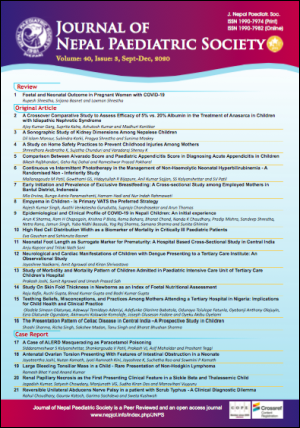Neurological and Cardiac Manifestations of Children with Dengue Presenting to a Tertiary Care Institute: An Observational Study
DOI:
https://doi.org/10.3126/jnps.v40i3.29572Keywords:
Keywords: Cardiac manifestation; Dengue; Neurological manifestations; NS1 antigen/ IgM antibodyAbstract
Introduction: Dengue is a common arboviral infection in tropical areas of world with increased incidence in the past few years. Spread of disease has led to increased recognition of various atypical manifestations apart from the classical features. This study was conducted to find out the neurological and cardiac manifestations of dengue in children.
Methods: This observational study was conducted in a tertiary referral centre in Central India. Cases were classified based on the WHO 2009 Dengue guidelines for the diagnosis, treatment, prevention and control. The neurological and cardiac manifestations of dengue were studied and compared with those cases without manifestations.
Results: In this study, a total of 75 dengue cases were included and out of them, five (6.75%) cases presented with CNS abnormalities. The most common neurological manifestations were fever with seizures, altered sensorium, vomiting and headache. Hepatomegaly, hypotension, coagulopathy, and leucocytosis (> 11,000 cells/mm3) were significantly associated with neurological dysfunction (p < 0.05). Ten children out of 75 (13.33%) had cardiac manifestations. They included bradycardia in five cases, tachycardia and signs of CCF in three cases and shock in two cases. Echocardiographic evaluation showed mild pericardial effusion in one patient.
Conclusions: Dengue poses a huge burden to healthcare system with its various atypical manifestations. A better understanding of neurological and cardiac clinical manifestations of dengue will reduce morbidity and mortality in such cases.
Downloads
Downloads
Published
How to Cite
Issue
Section
License
Authors who publish with this journal agree to the following terms:
Authors retain copyright and grant the journal right of first publication with the work simultaneously licensed under a Creative Commons Attribution License that allows others to share the work with an acknowledgement of the work's authorship and initial publication in this journal.
Authors are able to enter into separate, additional contractual arrangements for the non-exclusive distribution of the journal's published version of the work (e.g., post it to an institutional repository or publish it in a book), with an acknowledgement of its initial publication in this journal.
Authors are permitted and encouraged to post their work online (e.g., in institutional repositories or on their website) prior to and during the submission process, as it can lead to productive exchanges, as well as earlier and greater citation of published work (See The Effect of Open Access).



